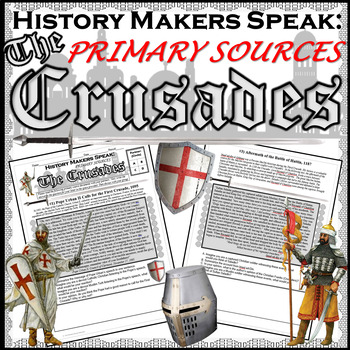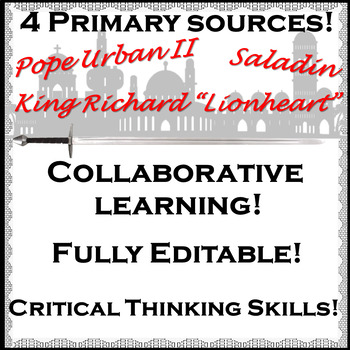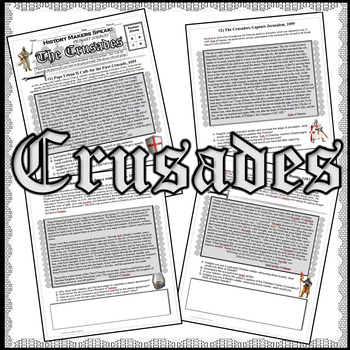Crusades History Makers Speak Primary Sources (Pope Urban II, Saladin, Richard)
- Zip
Description
Crusades History Makers Speak Primary Sources (Pope Urban II, Saladin, Richard)
Thank you considering this fully editable product!
The Crusades the most significant series of wars in the Middle Ages. I love to use this primary source activity in my World History classes. It really gets the students talking to one another, and is wonderful for small-group collaborative learning and class discussions. This is perfect for a Jr. High or High School class. This product will enable your students to learn about the Crusades with primary sources. Primary sources are vital in any social studies class, and are often important social studies standards as well.
WHAT'S INCLUDED:
There are two parts to this product:
1) a Word/Pdf document of the 4 primary sources
2) a Teacher Notes document that helps to explain the the excerpts a little more fully, with also likely student responses and explanations
The four primary sources:
#1) Pope Urban II Calls for the First Crusade, 1095: This is an excerpt of the impassioned call that started the Crusades. Pope Urban II makes it clear that the Turks have committed terrible crimes and the Crusaders must fight back and regain control of the “Holy Land.”
#2) The Crusaders Capture Jerusalem, 1099: This is a gripping eyewitness description of the siege and conquest of Jerusalem at the end of the First Crusade.
#3) Aftermath of the Battle of Hattin, 1187: This is a eyewitness description of Sultan Saladin’s interaction with King Guy and Lord Reynald after the battle of Hattin. Hattin was the battle that crushed much of the Crusader army. After Hattin, Saladin marched to Jerusalem and took it away from the Crusaders (which led to the Third Crusade)
#4) King Richard I Makes Peace with Saladin, 1192: This is a description of the confrontation between Saladin and King Richard “The Lionheart” during the Third Crusade. After several battles, there was ultimately a truce and peace agreement between the two.
TEACHING POINTS & PROCEDURES:
I usually incorporate this activity after giving the students some lecture background on the Crusades. Each of the 4 excerpts has an italicized intro background set-up to aid in context and student understanding. I break the students into groups of four. The students will then become partner A, B, C or D. I have the students read together, with the student reading aloud the source that matches his/her letter. I usually also tell student to circle, underline or highlight (annotate) key words phrases. After reading and annotating the text together, each student will answer the question or task that is aligned to his/her partner letter. The student writes the response in the space at the bottom of each page. The skills involved are textual comprehension, summarizing and critical thinking, with an emphasis upon trying to think what a person living in these times would think and feel. The student group then will discuss each of the A, B, C and D tasks, with each student taking turns offering an idea or opinion. I then will lead a class discussion where I can call on students to share their response for the different sources and letters. I try to make sure I spread the questions around, so each group is involved. This activity will certainly increase student interest and knowledge in the Crusades, as well as develop vital learning skills. Thank you and enjoy!
Please check out the Preview of this product.
I hope you enjoy this product. If so, please leave a positive comment. Thank you!
©2019 Premier History Materials





